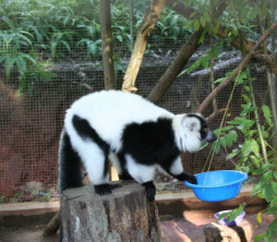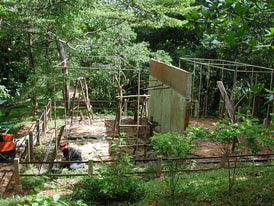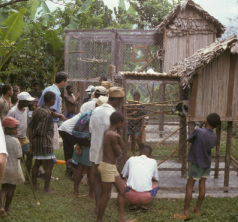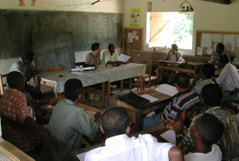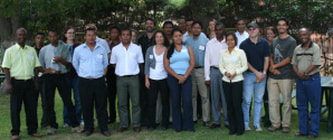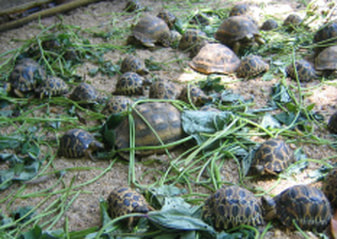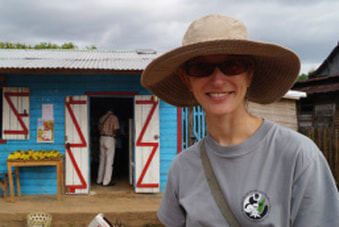The history of the MFG
|
1897
The French invaded Madagascar in 1894 and by 1896 the island came under French rule. Among other things, the French experimented with improving existing agriculture and testing the viability of exotic plants and crops in the tropical climate. Several agricultural research stations were established including the Jardin of Ivoloina in 1897. After Madagascar gained its independence in 1960, the Ivoloina site was placed under the jurisdiction of Eaux et Forets. Several years later the precursor to the zoo was built for the purpose of developing husbandry techniques to care for and breed some of Madagascar's threatened wildlife as well as house illegally obtained animals confiscated from private individuals. |
|
1986
A cyclone destroyed most of the cages and infrastructure of Parc Ivoloina's zoo. Already familiar with the work of Duke University's Lemur Center, the Malagasy government requested their assistance in helping to rebuild the zoo. Duke selected Andrea Katz and Charlie Welch to carry out the work. |
|
1987
The IUCN Primate Specialist Group, the Conservation Breeding Specialist Group and the New York Zoological Society organized a workshop held at St. Catherine’s Island that brought together key Malagasy government officials (from le Ministère des Eaux et Forêts, le Ministère de l’Enseignement Supérieur, le Ministère de la Recherche Scientifique), international zoo professionals, Duke Lemur Center and field scientists. Attention was primarily focused on how international zoos could assist the Malagasy government conserve threatened and endangered species through research, habitat protection, building local capacity and captive propagation, Prior to the formation of the MFG, zoos typically worked as individual institutions engaged in developing assorted relationships with officials within the complex structure of Madagascar's governing authorities, however in the absence of any coordination, even the best zoos' initiatives could end up working at cross-purposes. It was here that the concept of a zoo consortium was born; consortium members would contribute to species conservation efforts within Madagascar and ensure that only well-justified requests to export individual animals designated for regionally managed captive breeding programs would occur. The meeting resulted in the "St. Catherine’s Convention for Collaboration with respect to endangered Malagasy fauna" signed by the Malagasy Government representatives and the international parties. |
|
|
1988
The Madagascar Fauna Group was formed; David Anderson from the Audubon Zoo was chosen to serve as Chair; Andrea Katz and Charlie Welch were asked to stay on and continue their work, now funded through the MFG and Duke Lemur Center, as Technical Advisors to Parc Zoologique Ivoloina. They provided extensive training in zoo management including administrative and policy issues, facility design and maintenance, staff training and animal care. Four black and white ruffed lemurs from the American Association of Zoos and Aquarium's (AZA) Species Survival Plan (SSP) were transferred to Parc Ivoloina, that, at the time did not have the species in their collection. |
|
1989
A Protocol of Collaboration Phase I: 1989-1993 was developed between the MFG and the Ministere de l'Environnement, des Eaux et Forets which had jurisdiction over Parc Ivoloina and paid the staff's salaries. The MFG was asked to develop programs to increase environmental awareness, facilitate research and improve animal care, housing and personnel management at the Zoo. |
|
1990
After a great deal of work building new and better enclosures for the lemurs at Parc Zoologique Ivoloina, it was reopened to the public. Mme. Therese Ratodiarisoa, a local teacher, was hired with funding from the Wildlife Preservation Trust International to serve as the Zoo's Education Program Coordinator. Betampona Natural Reserve, approximately 40 km from Toamasina, was the closest intact rainforest to Parc Ivoloina with wild lemur populations. Charlie Welch received permission from Eaux et Forets, the same governmental agency with jurisdiction over Parc Ivoloina, to survey the Reserve's lemurs. Surveys were seen as a first step towards assessing whether Betampona could be considered as a potential site where conservation programs that include endangered lemur species' translocation or restocking programs. |
|
1991
The Malagasy government requested assistance from the MFG to improve the management of Parc Botanique & Zoologique Tsmibazaza (PBZT) located in the capital city of Antananarivo. Over a period of seven years, the MFG funded four technical advisors who focused on improving standards of animal care and record-keeping, staff training and supervision, increasing public education and awareness activities and developing a financial plan. In 1993 the MFG technical advisor worked with Zoo staff to establish admission fees for the first time and build a small gift shop to generate additional revenue. Sustaining progress was significantly more challenging at PBZT than Ivoloina because the former developed partnerships with other organizations whose objectives and standards did not always match those of the MFG's. In 1998 the MFG suspended its involvement with PBZT and focused its resources on Parc Ivoloina and Betampona Natural Reserve. |
|
1993
Over 12 months between November 1993 and August 1995 data on the behavior and habitat use of the wild population were collected by Adam Britt. This research was part of a comparative behavioral study of wild and captive V. v. variegata. The aim was to compare the feeding behavior of wild and zoo-housed ruffed lemurs and apply the results to develop husbandry protocols that would encourage increased exhibition of natural behavior patterns. His main conclusion was that captive-bred V. variegata appear to retain the skills required for survival in their natural habitat. Behavioral differences with regards to wild and captive Varecia is due to structural differences between the environments in which they live, rather than modifications associated with life in captivity. |
|
1995
The Saturday School Program at Parc Zoologique Ivoloina was initiated. Eleanor Sterling collaborated with Mme. Therese to enhance the Zoo's education programs. A teacher's guide to the Zoo was developed and printed and a poster discouraging the acquisition of lemurs as pets was launched with a radio and TV campaign. MFG Field Advisor, Dr. Patricia Wright located a small population of Prolemur simus near Karianga, southeast Madagascar, in an isolated forest fragment surrounded by farmed land and villages. Following numerous discussions a decision was made to capture a select number of individuals to establish an in-country captive breeding program. In November, MFG Chair David Anderson accompanied Pat Wright and her field team who were able to capture five individuals. The five were taken to the Ivoloina Zoo. Eight black and white ruffed lemurs (four pairs) were transferred from Ivoloina into the SSP Program. All the individuals had been illegally captured and brought to a market or sold directly to individuals as a pet and subsequently confiscated by Malagasy authorities. Because available housing for all the confiscated lemurs was limited and the SSP breeding program could benefit from the addition of new founders, the Government of Madagascar approved the permit to export them under the MFG's accord. After a three-month CDC quarantine at the Saint Louis Zoo, one pair remained in St. Louis while the others were distributed to the Philadelphia Zoo, Tulsa Zoo and Zoo Atlanta; all four pairs reproduced and thereby achieved the goal to increase the sustainability of the SSP population. |
|
|
1996 In January the Education Center was destroyed by a cyclone. With funds from the US Embassy, Susan and Robert Heath and the Oklahoma City Zoo, an improved and reinforced Education Center was built. Graphic artist, Elisabeth Winterwerb-Cossons, volunteered her skills to develop a series of panels illustrating Madagascar's diverse biomes, improving both the attractiveness and educational value of the classroom and visitors' center. |
|
1997
The first release of captive-born ruffed lemurs into Betampona Natural Reserve. Three males and two females were flown from Duke Lemur Center to Madagascar, driven and then carried to the MFG's Research Station where they were quarantined for a second time to insure they were free of infectious pathogens. They were then transferred to a temporary cage in the Reserve to habituate to their new environment before being released. All five were fitted with radio collars to enable the MFG's research team to monitor their progress. Adam Britt, who had completed his PhD and was already experienced with working in Betampona, was hired to lead the research program. The Saturday School Program was proving both successful and popular. However, Madagascar's National Environmental Action Plan called for increasing the environmental literacy of students and encouraged teachers to integrate environmental messages into their standard curriculum. In collaboration with a group of dedicated education officials and teachers, the MFG organized a series of workshops over a period of several years to produce what became a 65-page manual in Malagasy and French titled "A Practical Guide for the Teacher: the Application of Environmental Education in Primary School Instruction." |
|
|
1998 The second release of black and white ruffed lemurs from the SSP program into Betampona Natural Reserve occurred in November. This group was comprised of one male and three females. Radio collars were placed on all individuals for monitoring and research purposes by Adam Britt and Betampona's Conservation Agents. Data were collected on a wild group of ruffed lemurs and all the released individuals; a group was followed for a full or half day; behavioral observations were recorded using the instantaneous scan sampling method. The Betampona Agents continue to monitor the Varecia but their research activities and expertise have greatly expanded over the years; their presence has played a big role in protecting the Reserve.
|
|
1999
Adam Britt and Kellie Glasscock initiated a survey of Betampona's indri population. Indri, typically found in pairs with one or more offspring, are well known for their duets in which both male and female emit melodic loud calls. For species such as indri that reliably use long calls to communicate with each other or neighbors, duets can be used as an indirect measure to estimate population density. Applying this census method, Britt and Glasscock collected 167 hours of data between December 1999 and February 2000. To calculate density, they set the average group size at 3.3 which produced an estimated density of 6.9 individuals/km2 for a total population of 77. A second estimate, based on the home range size of three groups they had studied for 12 months, produced an estimated density of 14 individuals/km2 and a population of 155. The results they obtained indicated that Betampona's indri population was similar to the available information on indri populations in other rainforests. The Department of Water and Forests informed Program Managers Andrea and Charlie that there was apparent uncertainty regarding which Ministry actually had jurisdiction over Parc Ivoloina: the Ministry of Water and Forests or the Ministry of Agriculture; the MFG's Protocol of Collaboration was with Water & Forests. A new map was required as part of the administrative process to resolve the ownership dispute; arrangements were made for an official ground survey denoting the station's borders to enable the Service of Topography to produce the map. After months of waiting the issue was finally resolved in favor of Water and Forests. Paul Loiselle, Ph.D., works with Ivoloina staff to survey freshwater fish in the Ivoloina River System. |
|
|
2000
The Protocol of Collaboration Phase III 2000-2004 was signed. The MFG was now recognized by the government as the official operator of the Zoo and the entire Forestry Station. The MFG officially opened an office in Toamasina; a two-room space adjacent to the Hotel Miramar. Prior to this, the Program Managers had worked from their home or at Parc Ivoloina but, with the program growing, there was a need for both a secretary and a place to hold meetings. Dr. Paul Loiselle works with members of the MFG to survey freshwater fish populations of the Ivoloina River. |
|
2001
In May the MFG co-hosted an IUCN Conservation Breeding Specialist Group (CBSG) six-day Conservation Assessment and Management Plan (CAMP) workshop held in Madagascar. The purpose of the workshop was to use the IUCN Red List categories and criteria to assess the conservation status of five groups of vertebrates: 1) Lemurs, 2) Other Mammals, 3) Reptiles, 4) Amphibians and 5) Freshwater Fish. In addition, a Population and Habitat Viability Analysis (PHVA) was held for the Malagasy Giant Jumping Rat. The 88 people who attended the workshop were divided into working groups based on their taxonomic specialty. The results of the CAMP were published in July 2002 The third release of four black and white ruffed lemurs occurred in January. |
|
MFG
Conservation Medicine Advisor, Dr. Randy Junge, was invited by Dean of the College, Dr. Jhon Rasambainarivo, to assist in the development of courses and curricula. Randy recruited assistance from the University of Missouri’s College of Veterinary Medicine and after a site visit by Drs. Jeff Tyler and Alex Bermudez, a formal partnership was established in which UM pledged to collaborate through faculty training, development of computer assisted instruction programs and student exchanges. The veterinary program’s primary focus is training veterinarians in livestock health management. With only two zoos and no history of veterinary involvement in wildlife management, job opportunities for wildlife veterinarians in Madagascarare extremely limited. However, this will gradually change as science advances our understanding of how land use practices, habitat degradation and the composition of neighboring wildlife communities can interact to create detrimental health consequences for humans, their domestic animals and wildlife. Veterinarians trained in wildlife and conservation medicine will be able to make substantial contributions to the health and welfare of Madagascar’s human and wildlife communities. Veterinary Advisor, Dr. Randy Junge, who developed the veterinary protocols for the ruffed lemur restocking program and initiated the Prosimian Biomedical Survey Program, was invited by Dr. Jhon Rasambainarivo to assist in the development of courses and curricula. 2002 Madagascar's first College of Veterinary Medicine is inaugurated. MFG Veterinary Advisor, Dr. Randy Junge, who developed the veterinary protocol for the ruffed lemur restocking program and initiated the Prosimian Biomedical Survey Program, was invited by Dr. Jhon Rasambainarivo to assist in the development of courses and curricula. Although the focus was on training veterinarians to manage the health of the country's livestock, Dr. Junge also organized opportunities for the students to be introduced to the emerging field of conservation medicine through lectures at the College and the chance for select students to accompany veterinarians in the field. Over the years the MFG has developed close ties with the Veterinary College and in 2013 the partnership was formalized with the signing of a Protocol of Collaboration. |
|
2003
Program Managers Andrea Katz and Charlie Welch hold a series of meetings with the President of Toamasina Province, University of Toamasina faculty, ANGAP and Department of Water and Forests' employees, public school educators, and business leaders to help plan the MFG’s conservation strategy for the next five to ten years. Randriambelona is hired to replace the departing Mme Terese as Manager of the Center of Environmental Education (CEE). Randria expands CEE activities to include more activities for middle and high school students and initiates training workshops for village mayors. 2004 MFG's International Headquarters is transferred to the Saint Louis Zoo in November; Director & CEO Jeffrey Bonner is elected Chair; Ingrid Porton serves as Vice Chair. In February 2004, the MFG was awarded a renewable 25-year Ivoloina Management Contract signed by representatives of the Ministry of the Environment, Water and Forests and the Inter-Regional-Tamatave office of the Environment, Water and Forests. The contract gave the MFG full management authority and responsibility for all aspects of the Parc which was recorded as encompassing 282 hectares. In July 2004 the MFG's authority to manage the Parc was further strengthened when the land title was placed in the MFG's name. Although the land is still owned by the government the MFG was given full rights as the land tenant, a move that affords the Parc a greater level of protection from being turned over to developers or mining companies.
After dedicating 15 years of their lives towards developing the infrastructure, staff, program, relationships within the community and trusted reputation of the MFG, Program Managers Andrea Katz and Charlie Welch returned to the United States. In a ceremony that took place during Madagascar's Independence Day celebrations, President of Toamasina Province, Emile Tsizaraina, in the name of Madagascar's President, awarded Andrea and Charlie with the "Chevalier de l'Ordre National" (the National Medal of Honor of Madagascar). In his speech before a large audience, and which was later broadcast on national TV, President Tsizaraina detailed Andrea and Charlie's contributions to conservation through all their accomplishments at both Parc Ivoloina and Betampona Natural Reserve. Fortunately, Andrea and Charlie have remained fully involved as advisors to the MFG and their work at Duke Lemur Center. Karen Freeman, PhD was named MFG's new Program Manager; Gareth Kett, funded through the Saint Louis Zoo's WildCare Center, was hired to serve as Forestry Station Manager. Karen earned her PhD studying the ecology and genetics of three endangered gongylomorphus skink populations in Mauritius. Gareth earned his BSc in Rural Resource Management from the University of Plymouth, Devon and worked for 2 1/2 years as a biologist and warden in Mauritius before moving to Madagascar with Karen. |
|
2005
MFG Capacity Building Workshop held in St. Louis brought together five government and university representatives from Toamasina, MFG staff, advisors and local university faculty to discuss training needs and potential opportunities. The Malagasy leaders were particularly interested in building the institutional capacity of the University of Toamasina, providing more field experience for graduate students and developing environmentally sustainable practices to improve food production. Among several positive outcomes of the workshop was a partnership that developed between the MFG, the University of Toamasina and Dr. Christof den Biggelaar, Good Family Sustainable Development Program, Appalachian State University, North Carolina. Construction of the Ivoloina Conservation Training Center begins with a ceremony attended by Toamasina's political leaders, university faculty and environmental authorities and a large group of people from villages close to the parc. |
|
2006
Phase 1 of the Ivoloina Conservation Training Center (the meeting room, office/library and laboratory) was completed in June. The MFG held its annual meeting in Toamasina to enable those attending to join local business and political leaders, in-country collaborators, members of the community and special guest, the Minister of the Environment, at the grand opening. The MFG reinforced its partnership with the University of Toamasina with the signing of a formal Protocol of Collaboration with the University's Department of Natural Resources (GRENE). The protocol serves to advance MFG and GRENE's shared objective of using Parc Ivoloina's varied landscapes and facilities to gain hands-on field and lab experiences in research and natural resource management skills. Eric Miller, DVM, Director of the WildCare Institute and Senior Vice President, Saint Louis Zoo replaces Dr. Bonner as MFG Chair. Karen Freeman initiates research directed at understanding the scope of the problem invasive plants, with a particular emphasis on strawberry guava, pose to Betampona Natural Reserve; the Missouri Botanical Garden and MFG collaborate on a research program to propagate endangered tree species; Karen Freeman attends the IUCN's Conservation Strategy for the Amphibians of Madagascar Workshop held in Antananarivo and increases MFG's involvement in amphibian conservation programs. 2007
Dr. Christof den Biggelaar spends his six- month sabbatical in Toamasina. With funds from the American Association of Zoos and Aquariums' Conservation Endowment Fund, Dr den Biggelaar collaborated with the MFG and University of Toamasina to build local capacity in natural resource management through both formal (university-level) and non-formal (training of farmers, village leaders and MFG Parc Ivoloina personnel) education and applied research in ecological agriculture approaches and methods. Doug Daly, Ph.D., New York Botanical Garden and Jeannie Raharimampionona, Missouri Botanical Gardens/Madagascar survey Canarium in Betampona and discover new species. A comprehensive survey of Betampona's amphibians is carried out by Dr. Franco Andreone, Chair IUCN’s Declining Amphibian Populations Task Force for Madagascar, Master's student Gonçalo Rosa, Betampona Conservation Agent Jean Noel and Dr. Angelica Crottini. Using morphology, bioacoustics, ecological and genetic data the team identified 76 frog taxa including 36 candidate species, some of which may be endemic to the Reserve. Compared to much larger reserves, the extent of amphibian diversity within Betampona is considered impressive. |
|
|
2008
Karen Freeman and Gareth Kett return to the United Kingdom but, in her new role as Research Director, Karen continues to be a part of the MFG. Dr. An Bollen, replaces Karen as MFG Program Manager. An carried out her doctoral research on seed dispersal ecology in Sainte Luce, Fort-Dauphin, SE-Madagascar. She spent five months in Yemen as a scientific technical advisor to Socotra Conservation and Development Program and 2 1/2 years in Thailand with the UN's Environmental Program as an Associate Program Officer for Biodiversity & Climate Change issues before joining the MFG. The MFG received a grant from the European Association of Zoos and Aquariums to pilot a program to work with local people to reforest an area of land surrounding Betampona Natural Reserve. Slash and burn agriculture (tavy), a farming practice that is sustainable in areas of low human population density, has left Betampona's rainforest an "island" surrounded by a degraded landscape. The goal of the reforestation program is to involve local communities in planting trees in a 2 km area around the Reserve to help protect the forest while also providing a portion of the trees for commercial purposes. The program was approved by and managed in collaboration with the Reserve's managing authority, Madagascar National Parks. Permission for MFG Conservation Agents to collect seeds of native trees from "Classified Forests” surviving in the vicinity of Betampona was given by the Department of Water and Forests. |
|
|
2009
In January, dissatisfaction with some of President Ravalomanana's actions was growing in Antananarivo, Madagascar's capital. The city's mayor, Andry Rajoelina, a frequent critic of the President, held a series of rallies encouraging citizens to speak out against Ravalomanana's presidency. Increased tensions led to riots in Antananarivo with protesters targeting Ravalomanana's radio station and Magro warehouses. The violence spread to other parts of the country including Toamasina where Ravalomanana was never popular. One Magro warehouse, located directly across the street from the MFG's Office, was destroyed by local rioters. Packing up a few of the MFG's most valuable documents, the staff locked the office and stayed in a safer location for a few days. The political crisis continued for weeks and led to a military coup d'etat with Rajoelina declaring himself President of the newly formed High Transitional Authority. Donor countries withdrew their support and Madagascar fell deep into poverty. All aspects of society were affected including the MFG's programs. Cruise ships cancelled bookings, training workshops were delayed or cancelled, universities delayed the new semester and once started, class schedules were erratic, lack of law enforcement and corruption increased illegal logging, poaching and other environmental crimes. Although conditions were more difficult, the MFG continued its work. |
|
|
2010
In January the MFG hosted an International Technical Meeting "Conservation of the Critically Endangered Greater Bamboo Lemur, Prolemur simus: What we know now, what we need to know and potential conservation strategies". The objectives of the working meeting were to bring together field researchers, MNP and zoo biologists to share information on the captive and two known wild populations, identify threats, potential solutions and work towards developing a holistic conservation strategy for the species. Captive breeding may be a feasible and appropriate component of a larger conservation strategy for some endangered species. Both field and zoo biologists agree that the Critically Endangered greater bamboo lemur, Prolemur simus, classified as Critically Endangered, is such a species. Several European zoos and Parc Ivoloina have had success breeding P. simus. In 2007 the European population was organized into a cooperatively managed breeding program, the EEP (European Species Survival Program) led by Delphine Roullet. With the 2009 inclusion of Ivoloina Zoo's P. simus into the EEP, the program became one of the few managed at the global level. In February the Besancon and Ivoloina Zoos exchanged individuals to introduce a new founder into the European population; on 10 February a female, Bekily, arrived in Madagascar and on the 25th, young male, Raphael, was transferred to Besancon. Both individuals have successfully produced offspring. The radiated tortoise, Astrochelys radiata, is endemic to southern Madagascar's dry spiny forest. Their population used to number in the millions and even as few as 15 years ago their conservation status was only considered vulnerable. But in 2008 the situation for radiated tortoises was so alarming their status was changed to Critically Endangered. Two factors have led to their drastic population declines. The first is that local people continue to hunt them for their meat. The second factor is the insatiable international black market; indeed in 2011 TRAFFIC reported radiated tortoises as the most abundant species found in Asia's illegal pet trade. Hundreds of baby tortoises are hidden in luggage and stolen out of Madagascar every year. When Water and Forests Department authorities in Toamasina confiscate tortoises from people illegally holding them as pets or selling them to tourists, they bring them to Ivoloina. In earlier years, Zoo staff bred them to gain husbandry skills and because of their changing conservation status. However, breeding was discontinued (by separating the sexes) when conditions became too crowded. The MFG had hoped to one day transfer the tortoises back to their native habitat but it was not until 2010 when that hope was finally realized. Carefully placed in specially constructed housing units, 300 tortoises from the Ivoloina Zoo were driven 1300 km over a four day period to their new home, the Village de Tortues, in Mangily, Ifaty. 2011
Lala Randriatavy has been with the MFG in a variety of roles beginning in 2003 when he worked with Amanda Armstrong in Betampona while earning his DEA. Karen Freeman was impressed with his abilities and asked him to survey Ivoloina’s bird population. He left when he obtained a job but returned to the MFG when a position for CEE Manager was available in 2007. At that time the position included overseeing the ICTC in addition to managing the education program. In 2009 the workload was divided into two positions and Lala became the full time ICTC manager. Lala had long expressed his interest to earn a PhD so in 2010 when Karen discussed turning the invasive guava control trials into a dissertation topic, Lala jumped at the chance. After collecting baseline data, Lala and a team of men prepared the 3 research plots per condition for a total of 15 plots. The effectiveness of four manual control methods will be compared: 1) Control, no treatment, 2) Uprooting all guava, 3) Uprooting all guava and replanting with native trees, 4) Ring-barking and 5) Removing all leaves and branches. An Bollen returned to Belgium in September and Arnoud Steeman served as interim Program Manager through February 2012. |
|
|
2012
Maya Moore becomes the MFG's Program Director. Maya learned to speak Malagasy when she served as a Peace Corps volunteer from 2004 – 2006. She lived in a village north of Tamatave where she worked with farmers and extension agents on exploring more sustainable farming practices. Her love of Madagascar led her to accept a number of short-term contracts with different NGOs as well as obtain an MA in Sustainable International Development from Brandeis University prior to joining the MFG. UNICEF selected the MFG as one of four partners in Madagascar to participate in its "Connecting Classrooms, Communities and Youth for Biodiversity Conservation" (CCCYBC). The program is centered around the concept that facilitating opportunities for youth to learn about biodiversity and participate in green activities through connecting them with informational resources via the internet (if available) or printed materials, classrooms, youth clubs, conservation organizations, local parks and reserves and each other can create a social movement for biodiversity conservation. UNICEF adopted the MFG's Saturday School Program as a best practice model. The program was designed to prepare primary school children to pass their national exams to enable then to transition into secondary school. The program includes environmental activities however the MFG has long recognized a basic education is fundamental to an informed citizenry. |
|
2013
We celebrated the MFG's 25th year anniversary by officially changing our name (but not our acronym) to the Madagascar Fauna and Flora Group. We felt the addition better reflected our past and ongoing efforts to conserve Madagascar's endemic animal and plant species. This meant we also required a modified or new logo. We could not have been luckier than having our need arise at the same time we were already benefitting from the volunteer services of Jana Grabner, a trained and very gifted graphic artist. For our new logo we selected the black and white ruffed lemur to represent "fauna" based on our history with restocking the species into Betampona which, in turn, launched our conservation research partnership with Madagascar National Parks. The ruffed lemur's role as a seed disperser is increasingly recognized as essential to forest health, especially since Varecia may be the only species capable of dispersing the large seeds produced by some trees. Darwin's orchid not only represents flora but also another example of a plant/animal interdependency. The orchid was named for Darwin because the famous scientist predicted the orchid's long nectar-filled spur co-evolved with an animal pollinator. Possessing an exceptionally long proboscis, the Malagasy hawkmoth, was discovered after Darwin's death. In 2004 Chris Raxworthy, Ph.D., carried out a preliminary three-week amphibian and reptile inventory in Betampona, however, like the more extensive follow-up amphibian survey carried out on 2007 which identified additional taxa, the same was needed for Betampona's reptiles. Angelica Crottini, Franco Andreone, Daniele Salvi, James Harris, Emanuele Scaranini, Gonçalo Rosa plus Jean Noel and several additional MFG agents broke into two teams to cover more of the Reserve. About 40% of Madagascar’s reptiles are classified as threatened with extinction, however, completing the prerequisite survey work is required before accurate assessments of the island’s reptile diversity and conservation status can be made. The results of the survey will be published following data analyses. Of interest is that during the survey three new frogs were identified, increasing the number of Betampona’s amphibian taxa to 79. |
|





